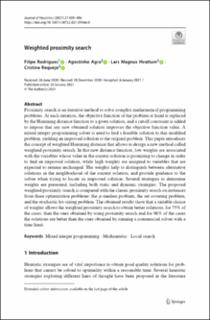| dc.contributor.author | Rodrigues, Filipe | |
| dc.contributor.author | Agra, Agostinho | |
| dc.contributor.author | Hvattum, Lars Magnus | |
| dc.contributor.author | Requejo, Cristina | |
| dc.date.accessioned | 2023-11-08T13:11:40Z | |
| dc.date.available | 2023-11-08T13:11:40Z | |
| dc.date.created | 2021-03-31T10:47:47Z | |
| dc.date.issued | 2021 | |
| dc.identifier.citation | Journal of Heuristics. 2021, 27 (3), 459-496. | en_US |
| dc.identifier.issn | 1381-1231 | |
| dc.identifier.uri | https://hdl.handle.net/11250/3101429 | |
| dc.description.abstract | Proximity search is an iterative method to solve complex mathematical programming problems. At each iteration, the objective function of the problem at hand is replaced by the Hamming distance function to a given solution, and a cutoff constraint is added to impose that any new obtained solution improves the objective function value. A mixed integer programming solver is used to find a feasible solution to this modified problem, yielding an improved solution to the original problem. This paper introduces the concept of weighted Hamming distance that allows to design a new method called weighted proximity search. In this new distance function, low weights are associated with the variables whose value in the current solution is promising to change in order to find an improved solution, while high weights are assigned to variables that are expected to remain unchanged. The weights help to distinguish between alternative solutions in the neighborhood of the current solution, and provide guidance to the solver when trying to locate an improved solution. Several strategies to determine weights are presented, including both static and dynamic strategies. The proposed weighted proximity search is compared with the classic proximity search on instances from three optimization problems: the p-median problem, the set covering problem, and the stochastic lot-sizing problem. The obtained results show that a suitable choice of weights allows the weighted proximity search to obtain better solutions, for 75% of the cases, than the ones obtained by using proximity search and for 96% of the cases the solutions are better than the ones obtained by running a commercial solver with a time limit. | en_US |
| dc.language.iso | eng | en_US |
| dc.relation.uri | https://doi.org/10.1007/s10732-021-09466-0 | |
| dc.rights | Navngivelse 4.0 Internasjonal | * |
| dc.rights.uri | http://creativecommons.org/licenses/by/4.0/deed.no | * |
| dc.title | Weighted proximity search | en_US |
| dc.type | Peer reviewed | en_US |
| dc.type | Journal article | en_US |
| dc.description.version | publishedVersion | en_US |
| dc.source.pagenumber | 459-496 | en_US |
| dc.source.volume | 27 | en_US |
| dc.source.journal | Journal of Heuristics | en_US |
| dc.source.issue | 3 | en_US |
| dc.identifier.doi | 10.1007/s10732-021-09466-0 | |
| dc.identifier.cristin | 1901809 | |
| dc.relation.project | Norges forskningsråd: 263031 | en_US |
| cristin.ispublished | true | |
| cristin.fulltext | original | |
| cristin.qualitycode | 2 | |

